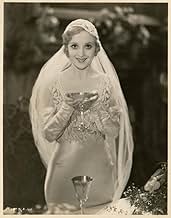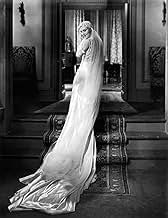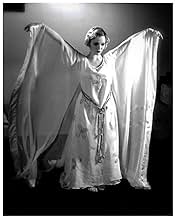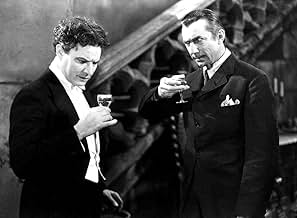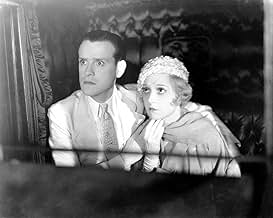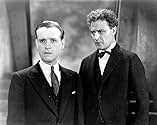A young man turns to a witch doctor to lure the woman he loves away from her fiancé, but instead turns her into a zombie slave.A young man turns to a witch doctor to lure the woman he loves away from her fiancé, but instead turns her into a zombie slave.A young man turns to a witch doctor to lure the woman he loves away from her fiancé, but instead turns her into a zombie slave.
John T. Prince
- Ledot - Zombie
- (as John Printz)
Clarence Muse
- Coach Driver
- (uncredited)
Featured reviews
This review will be more about the print and theatrical experience than about the plot. Most people won't find this "useful", but hey, so what. Here's my two cents.
If you have the opportunity to see the Roan Group print projected in a theater, don't hesitate. Go see it.
I just saw this in the big screen last weekend and it is MUCH better in a proper theater with a crowd of enthusiasts than in the confines of your home, even with a big TV and 5.1. The audience I was in was comprised of about 150 kids and their parents. The kids had a great time as did I, who has seen the movie several times over the years in the washed out public domain video prints that have circulated forever.
The Roan Group print (same as the remastered DVD) is the one we saw, projected in 35 mm. It was obvious that there were two sources for this print. The vast majority of this appears to come from a very nice print with high contrast and sharp definition. The "fill-in" portions, apparently missing from the other source, are much more typical of a 75-year-old cheapie independent production shot in 11 days, i.e., scratchy, multiple generations removed from the negative, and faded. Thankfully there's not too much from that second source. There are a few jumps in the film (a few seconds at most) that could not be restored. Too bad, but no biggie.
The sound was problematic, veering from a comfortable volume when dialogue was speaking, to way too loud, almost to the point of distortion, when the music played or the bird squawked. I really don't think it was the theater's fault as their sound is always "just right".
Interestingly, for a movie this old (pre King Kong and Bride of Frankenstein) there was a whole lot of music and not as much dialogue as one usually gets in a film from this era. The music was rarely background to dialogue and was used almost exclusively to enhance the mood of the film. It was probably cheaper to do it this way, but who cares why. It works.
This is a really neat film full of great shots and creepy characters. Bela is fantastic, maybe his best performance on film. White Zombie hardly ranks up there with the Universal classics of the era, but it is positively time for a historical and critical reappraisal of this newly restored film.
It's good on video, but on the big screen, WOW!
If you have the opportunity to see the Roan Group print projected in a theater, don't hesitate. Go see it.
I just saw this in the big screen last weekend and it is MUCH better in a proper theater with a crowd of enthusiasts than in the confines of your home, even with a big TV and 5.1. The audience I was in was comprised of about 150 kids and their parents. The kids had a great time as did I, who has seen the movie several times over the years in the washed out public domain video prints that have circulated forever.
The Roan Group print (same as the remastered DVD) is the one we saw, projected in 35 mm. It was obvious that there were two sources for this print. The vast majority of this appears to come from a very nice print with high contrast and sharp definition. The "fill-in" portions, apparently missing from the other source, are much more typical of a 75-year-old cheapie independent production shot in 11 days, i.e., scratchy, multiple generations removed from the negative, and faded. Thankfully there's not too much from that second source. There are a few jumps in the film (a few seconds at most) that could not be restored. Too bad, but no biggie.
The sound was problematic, veering from a comfortable volume when dialogue was speaking, to way too loud, almost to the point of distortion, when the music played or the bird squawked. I really don't think it was the theater's fault as their sound is always "just right".
Interestingly, for a movie this old (pre King Kong and Bride of Frankenstein) there was a whole lot of music and not as much dialogue as one usually gets in a film from this era. The music was rarely background to dialogue and was used almost exclusively to enhance the mood of the film. It was probably cheaper to do it this way, but who cares why. It works.
This is a really neat film full of great shots and creepy characters. Bela is fantastic, maybe his best performance on film. White Zombie hardly ranks up there with the Universal classics of the era, but it is positively time for a historical and critical reappraisal of this newly restored film.
It's good on video, but on the big screen, WOW!
You have to change your way of looking at movies to really enjoy old horror movies like this one. Don't be in a rush to see action, violence and don't expect to see any bloodshed at all. Most of the grisly part is implied and you have to fill in the details. Instead, watch it for the scenery, the acting and the plot.
I prefer the older horror films to the newer, slash-fest movies because they allow me to think and they generally have a good, moral theme. You never have a good guy as a demon or a fiend, for instance.
White Zombie has the older, traditional zombie characters that are not evil in themselves. Instead, they are mindless and controlled by a shaman, who is generally evil and must be destroyed to set the zombies, who are victims, free. In the newer Zombie movies like Night of the Living Dead, the Zombies are either not controlled or are evil themselves and must be destroyed.
I think the acting by the zombies is very good and so is their make-up (i.e. they have very frightening faces.) Their master, played by Bela Lugosi, is also played masterfully. The missionary is also good, but most of the rest of the cast is only average.
It's a fun movie to watch and I gave it a score of 7 out of 10. If you love early horror movies, buy it. Don't pay more than $10 unless it's packaged with other movies because the picture and the sound quality are weak. If not, you might catch it on a Friday night horror fest on TV. It's worth the time watching it if for Bela Lugosi alone.
I prefer the older horror films to the newer, slash-fest movies because they allow me to think and they generally have a good, moral theme. You never have a good guy as a demon or a fiend, for instance.
White Zombie has the older, traditional zombie characters that are not evil in themselves. Instead, they are mindless and controlled by a shaman, who is generally evil and must be destroyed to set the zombies, who are victims, free. In the newer Zombie movies like Night of the Living Dead, the Zombies are either not controlled or are evil themselves and must be destroyed.
I think the acting by the zombies is very good and so is their make-up (i.e. they have very frightening faces.) Their master, played by Bela Lugosi, is also played masterfully. The missionary is also good, but most of the rest of the cast is only average.
It's a fun movie to watch and I gave it a score of 7 out of 10. If you love early horror movies, buy it. Don't pay more than $10 unless it's packaged with other movies because the picture and the sound quality are weak. If not, you might catch it on a Friday night horror fest on TV. It's worth the time watching it if for Bela Lugosi alone.
White zombie is recorded as being the first Zombie movie ever mad. They Zombie actors did an amazing job of it, especially when considering they had no bases to work from. It was all about portraying creepy and terrifying through a stiff body poster and facial features. And they pooled it off. It was the "eyes" of Lugosi, the king of Zombies who put the fear in me. Amazing skills as an actor to convey so much with just the eyes. The movie is at one scary, mysterious, weird, and funny. The key feature of White zombie is that it was made to scar the people of its time, not ours. And this is probably why most people won't give it the time of day. It is an old movie with old style acting and scare tactics. The viewer has to know that be for watching it.
A couple of years ago I saw the 1931 version of Dracula as part of a live performance for the new musical score composed by Philip Glass. Even in this refined setting, the film was met by laughter from the audience during several sections. This seemed rather odd to me, but I suppose older horror films cannot help but lose some of their initial impact over time. The black and white photography and performance techniques became antiquated, hence humorous to some. As time went on, filmmakers begin to spoof the broad overacting and dramatic music of the vintage horror picture. It is impossible today to view a film like WHITE ZOMBIE and fully understand the impact it may have had in 1932. It does, however, escape (for the most part anyway) the mirthful reactions described above.
Director Victor Halprin's telling of this tale is often cited as the genesis of the "zombie picture." There is some debate about this, but WHITE ZOMBIE is certainly one of the early films to deal with the Haitian legend of "the dead that walk." The story revolves around a young couple who have traveled through Haiti to meet with their friend and benefactor Charles Beaumont (Robert Frazer), at whose villa they plan to be married. He has designs on the young bride, Madeleine (Madge Bellamy), and enlists the help of Murder Legendre (the name kind of says it all) played by Bela Lugosi. After the wedding, Legendre performs some "witchcraft" rituals and Madeleine falls into a death-like state. Believing that she has in fact died, the newly minted groom (John Harron) spirals into a drunken maelstrom, eventually seeking out the learned missionary Dr. Bruner (Joseph Cawthorn) to help solve the mystery. All paths seem to lead back to Legendre as the plot thickens and Beaumont's true motives are discovered.
It is fascinating to watch these type of films, some of which, like WHITE ZOMBIE age well with time. This is partly due to the fact that it has been largely forgotten in the wake of the more successful Universal horror flicks. The main drawn here will be the performance by Lugosi. He essentially "vamps" his role in Dracula, but manages to fashion a fairly distinct and unsettling screen presence. It would be roles like this however that would lead to his rigid typecasting; as time went on, he was all but discarded by the film industry (see ED WOOD [1994] for his later years). Halprin's direction focuses on atmosphere and gloom. He is well paired with cinematographer Arthur Martinelli and together they create a suitably shadow-laden backdrop for this macabre story. WHITE ZOMBIE is ambitious in camera angles and editing. At one point there is a diagonal wipe edit, which stops midscreen to reveal the actions of two separate characters. This type of effect is effortless to achieve now, but must have been laborious in 1932. Observe also the unusually large transitional set of the plantation interior, or the framing of Lugosi though the ornate stone work during certain shots. These small details help set WHITE ZOMBIE apart by creating a realistic environment and aid in visually representing the pathology of the characters.
Since the 30's there has been countless movies about killer zombies run amuck. The concept predominantly became fodder for B-grade schlock productions. The genre would experience something of a renaissance in 1968 with George Romero's NIGHT OF THE LIVING DEAD which created quite a stir at the time and resulted in zombies becoming, once again, fashionable. The Haitian setting of WHITE ZOMBIE would also be revisited in THE SERPENT AND THE RAINBOW (1988) and the "undead" as a means of cheap labor subtext would be exploited for darkly comedic effect in the underrated HBO film CAST A DEADLY SPELL (1991). In recent years, there has been such a boom of these "living dead" productions that it is hard to keep track of them all. WHITE ZOMBIE, as an early example of this current trend, but should be seen as more than just a footnote in the ever growing history of film. It is not a great movie, like Dracula, but will prove to be of interest to film buffs at least. It has more to offer, though, and I hope that it will continue to be rediscovered by successive generations. 7/10
Director Victor Halprin's telling of this tale is often cited as the genesis of the "zombie picture." There is some debate about this, but WHITE ZOMBIE is certainly one of the early films to deal with the Haitian legend of "the dead that walk." The story revolves around a young couple who have traveled through Haiti to meet with their friend and benefactor Charles Beaumont (Robert Frazer), at whose villa they plan to be married. He has designs on the young bride, Madeleine (Madge Bellamy), and enlists the help of Murder Legendre (the name kind of says it all) played by Bela Lugosi. After the wedding, Legendre performs some "witchcraft" rituals and Madeleine falls into a death-like state. Believing that she has in fact died, the newly minted groom (John Harron) spirals into a drunken maelstrom, eventually seeking out the learned missionary Dr. Bruner (Joseph Cawthorn) to help solve the mystery. All paths seem to lead back to Legendre as the plot thickens and Beaumont's true motives are discovered.
It is fascinating to watch these type of films, some of which, like WHITE ZOMBIE age well with time. This is partly due to the fact that it has been largely forgotten in the wake of the more successful Universal horror flicks. The main drawn here will be the performance by Lugosi. He essentially "vamps" his role in Dracula, but manages to fashion a fairly distinct and unsettling screen presence. It would be roles like this however that would lead to his rigid typecasting; as time went on, he was all but discarded by the film industry (see ED WOOD [1994] for his later years). Halprin's direction focuses on atmosphere and gloom. He is well paired with cinematographer Arthur Martinelli and together they create a suitably shadow-laden backdrop for this macabre story. WHITE ZOMBIE is ambitious in camera angles and editing. At one point there is a diagonal wipe edit, which stops midscreen to reveal the actions of two separate characters. This type of effect is effortless to achieve now, but must have been laborious in 1932. Observe also the unusually large transitional set of the plantation interior, or the framing of Lugosi though the ornate stone work during certain shots. These small details help set WHITE ZOMBIE apart by creating a realistic environment and aid in visually representing the pathology of the characters.
Since the 30's there has been countless movies about killer zombies run amuck. The concept predominantly became fodder for B-grade schlock productions. The genre would experience something of a renaissance in 1968 with George Romero's NIGHT OF THE LIVING DEAD which created quite a stir at the time and resulted in zombies becoming, once again, fashionable. The Haitian setting of WHITE ZOMBIE would also be revisited in THE SERPENT AND THE RAINBOW (1988) and the "undead" as a means of cheap labor subtext would be exploited for darkly comedic effect in the underrated HBO film CAST A DEADLY SPELL (1991). In recent years, there has been such a boom of these "living dead" productions that it is hard to keep track of them all. WHITE ZOMBIE, as an early example of this current trend, but should be seen as more than just a footnote in the ever growing history of film. It is not a great movie, like Dracula, but will prove to be of interest to film buffs at least. It has more to offer, though, and I hope that it will continue to be rediscovered by successive generations. 7/10
White Zombie is beautiful to watch, a combination of gorgeous black and white photography and wonderfully rendered matte paintings, and combo shots. I found the ending somewhat underwhelming, especially in light of some foreshadowing which does not pay off. Nonetheless, a true classic, even more fascinating if viewed through the lens of more informed understandings of colonialism, slavery, and related race relations.
Did you know
- TriviaWas a personal favorite of Bela Lugosi, according to his son, Bela Lugosi Jr..
- Goofs(at around 46 mins) The vulture manages to scream, loudly and repeatedly, with its beak shut.
- Quotes
Madeline: Driver, who were those men we saw?
Coach Driver: They are not men, madame. They are dead bodies!
- Crazy credits"White Zombie starring Bela (Dracula) Lugosi."
- Alternate versionsThe scene is which the zombie is crushed by the grinder, after falling into the chute in the factory, is missing from most available prints.
- ConnectionsEdited into Revolt of the Zombies (1936)
- SoundtracksBridal Chorus (Here Comes the Bride)
(uncredited)
from "Lohengrin"
Music by Richard Wagner (1850)
Played on an organ for the wedding
- How long is White Zombie?Powered by Alexa
Details
Box office
- Budget
- $50,000 (estimated)
- Runtime1 hour 9 minutes
- Color
- Aspect ratio
- 1.37 : 1
Contribute to this page
Suggest an edit or add missing content




